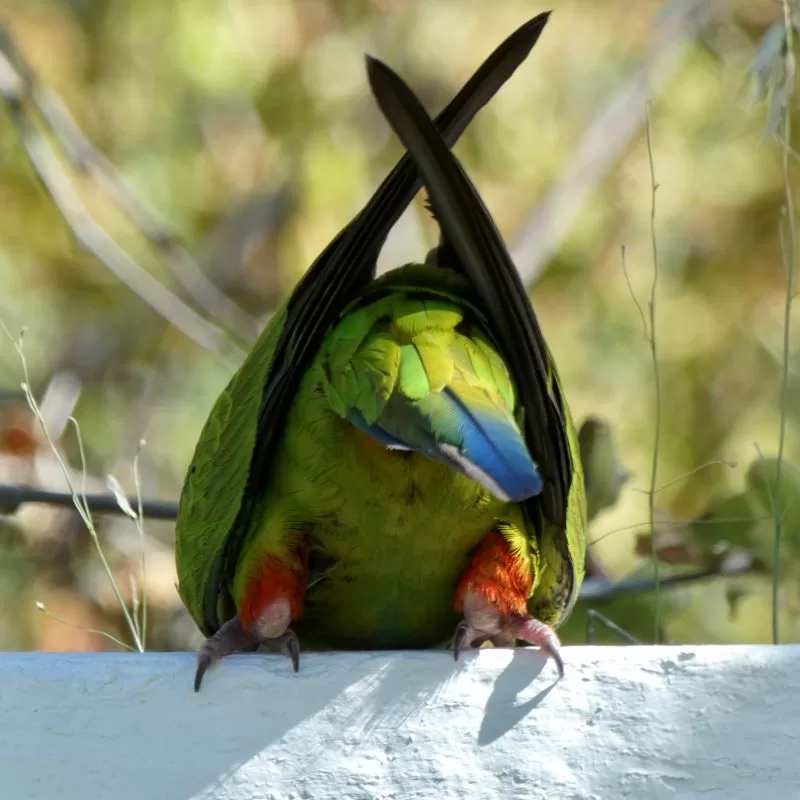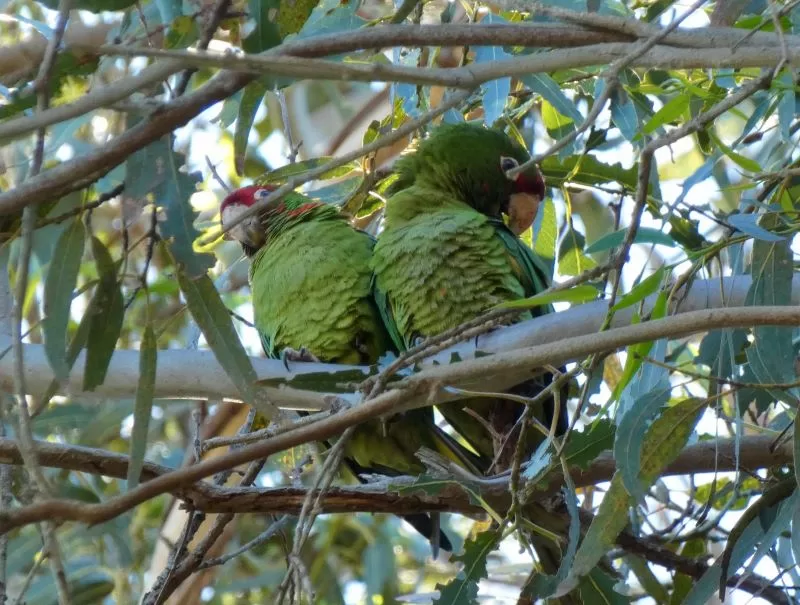
Almost every spring for the last eight years, mitered parakeets have nested in the old windbreak of eucalyptus trees that borders our garden. By the end of August, the young parrots and their parents have rejoined the local parrot flock. The birds’ bright green and red feathers fill the air with a tropical splash of color. Their conversation, carried out at full volume in shrieks and cackles, suggest a good-natured coven of witches rehearsing for their scene in Macbeth. The loud chatter and the flashes of bright green feathers have become part of life in the Santa Monica Mountains, but this robust, intelligent and adaptable species, Psittacara mitratus, belongs in South America, not the Santa Monica Mountains.
Natural History Museum of Los Angeles Ornithologist Garrett Kimball, the Collections Manager for the ornithology collection at the Natural History Museum of Los Angeles has been monitoring naturalized bird populations in the Los Angeles region since the early 1990s. In 1997 he published a study of naturalized parrots in the journal Western Birds, reporting on ten species in the greater Los Angeles area. Kimball concluded at the time that parrot populations would likely continue to expand. They have.
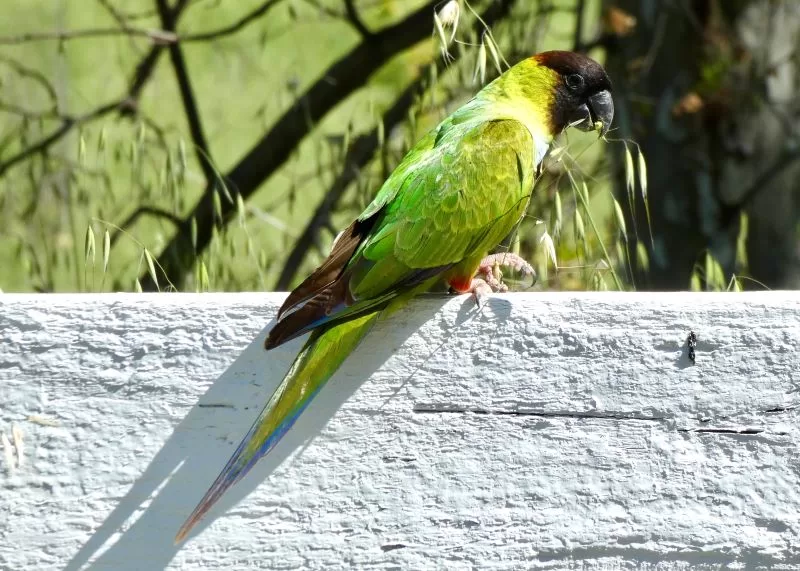
The most commonly seen—and heard—parrot in the Topanga area is the Nanday parakeet (Aratinga nenday), also known as a Nanday conure. These sleek green birds are more slender and streamlined than their cousins the mitered parakeets. They have dark feathers on their heads, which give them their other common name: black-hooded parakeets, but they also have vivid blue wingtips and bright red pantaloons.
These are the gregarious, loud, and acrobatic parrots that one encounters quarreling with the crows over the best trees for evening roosting, and catching the late afternoon sun on their vivid wings as they congregate in vociferous groups in the evening.
“Nanday Parakeets have become quite common in parts of the Santa Monica Mountains after having spread westward from the Brentwood/Pacific Palisades areas over the past 20 years or so,” Kimball told me. “They’re now routinely seen in residential areas on both sides of the canyons.”
Kimball told me that it is difficult to determine the total population because the birds move around frequently but that, at the time, he estimated there were 300 or more in the area, including Topanga.
“We don’t know how many separate sub-populations exist within the Santa Monicas, but it seems likely there are a few,” Kimball explained.
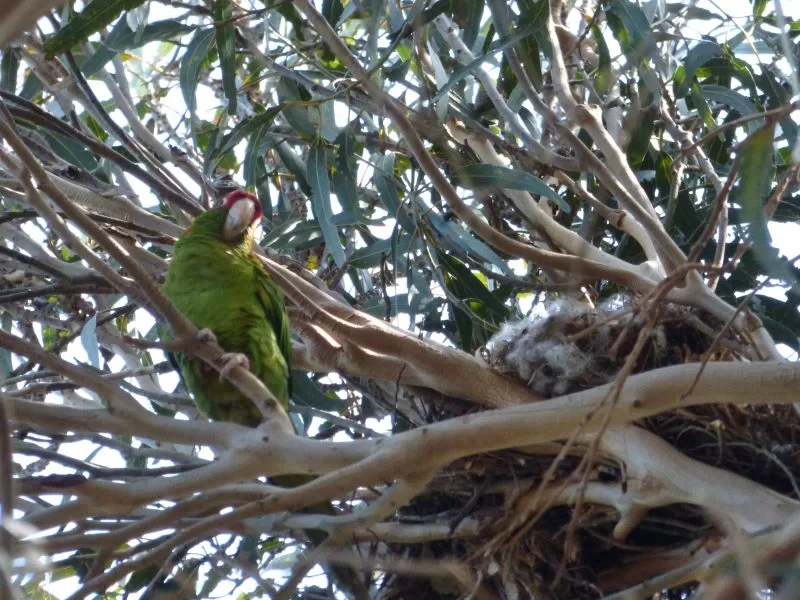
When I spoke with Kimball, mitered parakeets, like the ones that nest in our trees, were more likely to be spotted at the western end of the Santa Monica Mountains, but this colorful bird appears to be thriving and its range expanding. More remarkably, the mitered and nanday parakeet populations in the western Santa Monica Mountains successfully weathered the 2018 Woolsey Fire, which burned fully half of the range. On the day Malibu Creek State Park reopened after the fire, the resident Nanday parakeets were busy, harvesting sycamore seeds from trees that were spared from the fire, while the Point Dume mitered parakeet population sought shelter in unburned trees, an inspiration for the human survivors of the fire. Both parakeet species are smart, adaptable, and long-lived. Qualities that have enabled them to successfully naturalize and even flourish.
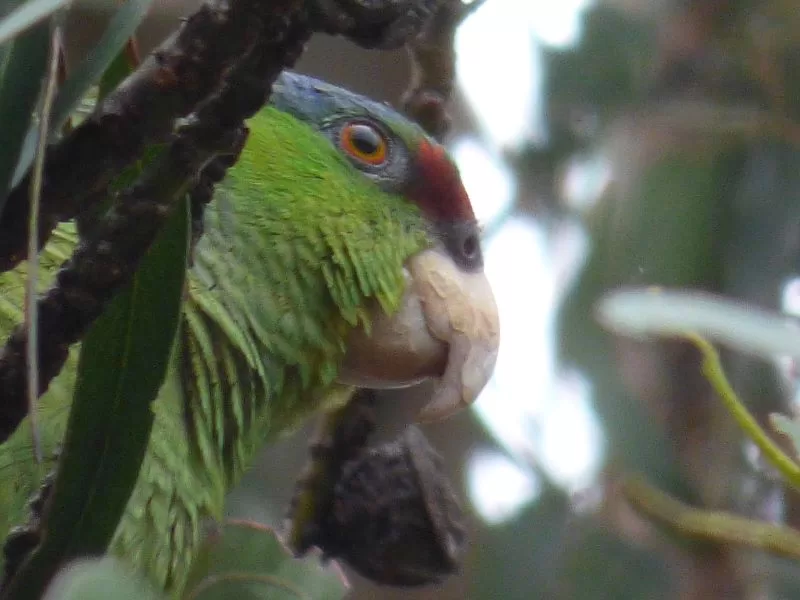
Several types of Amazon parrots are also making themselves at home in the Santa Monica Mountains. Lilac-crowned parrots (Amazona finschi) are green with a small amount of dark red on their faces and the name-sake lilac color on their heads. Red-crowned parrots (Amazona viridigenalis) have a much brighter red patch above the beak, and grey-blue coloring on the top of their heads. They also have a flash of red and yellow on their wings, visible when they fly. Sometimes yellow-crowned parrots are also up in the company of the other species.
All of these colorful immigrants have integrated themselves so well into the environment that it’s hard to imagine the area without them. When the first parrots began to show up in urban LA, the theory was that they were simple vagrants who arrived by accident. The first documented sighting—a group of six green parrots—was reported in Monrovia in October of 1958. A report in the Daily News Post quotes authorities at the Los Angeles Arboretum, who speculated that the birds were blown off course by a tropical storm. A year later the flock was spotted again, this time with new members. The news report included speculation that this group had formed a breeding colony.
Today, the prevailing theory is that California’s parrots descended from birds that escaped captivity, or possibly were released when owners discovered that the wild-caught birds were not pets.
Parrots skyrocketed to popularity as pets in the late nineteenth and early twentieth century. Newspaper stories are full of accounts of parrot hunters and parrot ranchers, and parrot smugglers. A Los Angeles Evening Express story from October of 1907 talks about unscrupulous dealers selling unsuspecting customers wild birds “These trapped parrots the dealers call “bronchos,” because they are intractable as a wild horse….In Mexico these birds are sold around the railway stations and seaports, and many well-meaning tourist invests in them.”
Birds like these, born for life in the wild and dumped by their purchasers, or eager to escape at the first chance, are thought to have been California’s first “wild” parrots.
The illegal trade in parrots peaked in the 1980s and 1990s, a time when Los Angeles’ wild parrots began to draw the attention of scientists like Kimball.
Wild parrots are currently found throughout California’s coastal cities and mountain ranges, and there are populations in Texas and Florida. The tropical and semi-tropical garden plants that have become the defining characteristic of the California garden provide critical habitat for parrots. In the Santa Monica Mountains, the canyons with year-round water and food sources like sycamore seeds also offer refuge. For at least one species, this home away from home has become an unlikely chance for survival. The red-crowned parrot now thriving in California is critically endangered in its native northeastern Mexico, where habitat loss and the illegal pet trade continues to push this bird towards extinction.
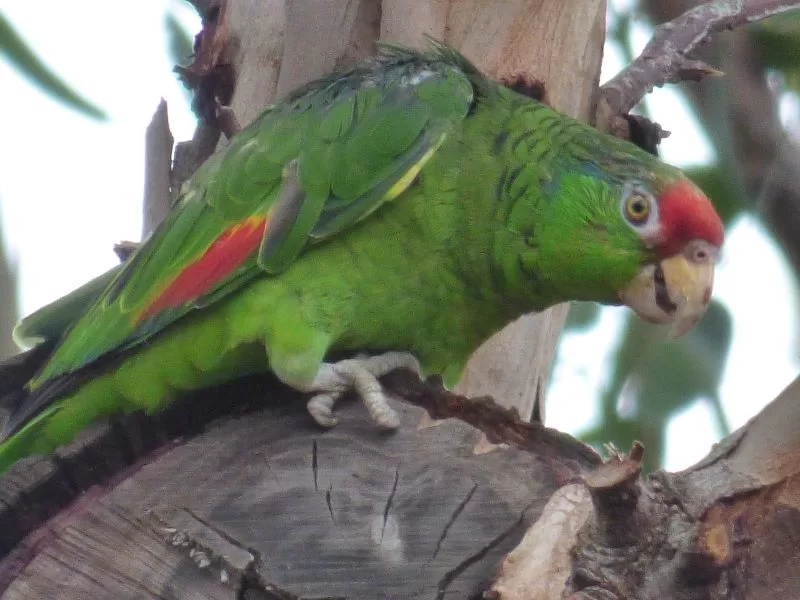
In a June 2018 editorial, Ursula Heise, the Marcia Howard chair in literary studies and a professor at UCLA’s Institute of the Environment and Sustainability wrote about how a city like Los Angeles can provide an unexpected sanctuary for a non-native species like the red-crowned parrot.
“Cities like Los Angeles not only destroy habitat, but also create new living spaces for animals and plants,” she wrote. In the Los Angeles area, there are about 2,000 to 3,000 red-crowned parrots, a number that could at this point rival or exceed that of the remaining wild population in Mexico.”
Heise asks whether urban areas like L.A. could also one day “deliberately offer sanctuary to endangered species…those that are native, of course, but also those that are not.”
The trees our parakeets nest in were planted in 1947, just a decade before the first LA parrot sightings were reported. These colorful birds weren’t here when I was a child, and I can’t definitely say when they first arrived, but I can’t imagine the garden without them. When I stop typing and listen for a moment, I hear the bushtits twittering in the garden, the distant cawing of the crows punctuated by the call of a red-tailed hawk, and louder and shriller than those other voices, the raucous calls of the parakeets, on their way home to roost for the night: part of the soundtrack of life in the Santa Monica Mountains.
